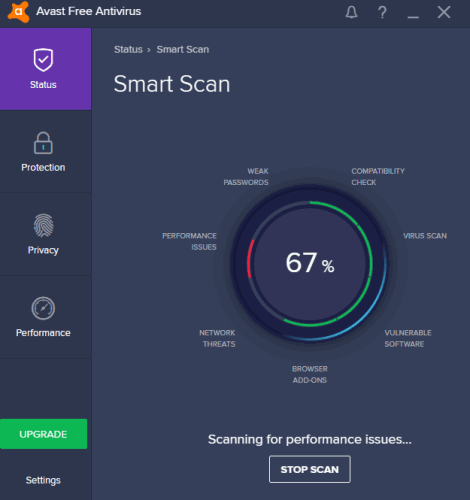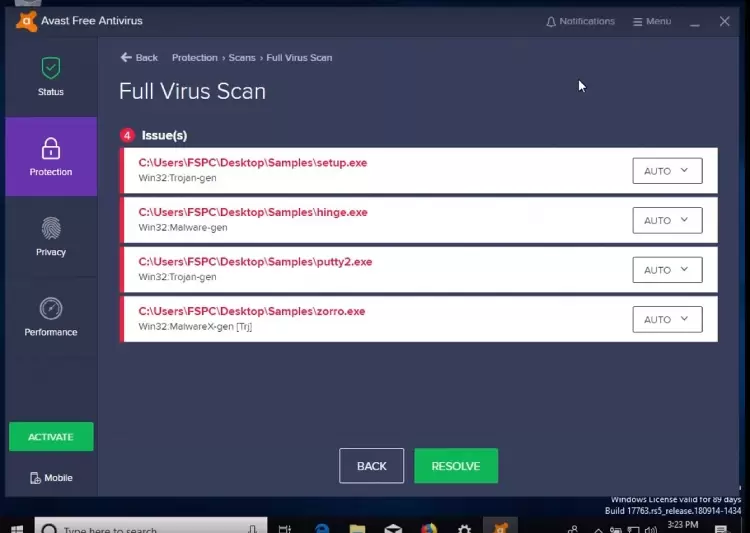

- Avast free antivirus scheduled scan install#
- Avast free antivirus scheduled scan update#
- Avast free antivirus scheduled scan manual#
- Avast free antivirus scheduled scan full#
- Avast free antivirus scheduled scan pro#
avgscanx.exe (AVG Command-line Scanning Utility) 9,716 K during scanning only.avgcsrvx.exe (AVG Scanning Core Module – Server Part) 336K and 7,000K during scanning.avgrsx.exe (AVG Resident Shield Service) 400K and 15,500K during scanning.sidebar.exe (to run the desktop gadget) 10,644K.vprot.exe (VProtect Application for SafeSearch) 6,528K.avgidsagent.exe (AVG Identity Protection Service) 12,816K.avgnsx.exe (AVG Online Shield Service) 236K.avgwdsvc.exe (AVG Watchdog Service) 13,200K.I was surprised to see 10 processes for AVG: But it took another two minutes to analyze and update, including a 65.8MB virus definition update. After the eight minute installation, a reboot wasn’t required. The initial download file was a meager 3.71MB, but an additional 53.7MB was downloaded during the install. It requires an Intel Pentium 1.5 GHz or faster process with 512 MB of RAM and a whopping 950 MB of free disk space.

Unlike with the other programs, I didn’t find any settings in CIS to limit CPU or resource usage.ĪVG Anti-Virus Free 2012 – AVG Anti-Virus Free 2012 supports Windows XP, Vista, and 7. For instance, I saw memory usage around 19,496K at idle and 61,520K while scanning.

If you do, you’ll see a reduction in resource consumption.
Avast free antivirus scheduled scan install#
This is included in the install by default but you can easily opt out of it during the installation. Keep in mind, the bottom two processes in the list above are for the optional GeekBuddy service COMODO provides. During the six minutes it took to scan 201,909 items, the memory usage was very sporadic but averaged around 91,916K and 5 percent to70 percent CPU usage.
Avast free antivirus scheduled scan full#
They recommend a full scan after install, but they also offer a critical areas scan, which is what I ran. While idle these add up to 49,892K of memory usage.
Avast free antivirus scheduled scan update#
But it did require a 10 minute update process, including a 142MB download. Like avast, the installation only took about three minutes and didn’t require a reboot. The download file at 59.7MB was the biggest of those I reviewed, but I didn’t have to do any further downloading during the install. It requires 128 MB of RAM and 350MB of free disk space. I also found two useful scan scheduling settings for laptops: you can enable it to not start if running on batteries and pause if you begin to use batteries.ĬOMODO Internet Security 5.5 – COMODO Internet Security (CIS) supports Windows XP SP2 or higher, Vista, and 7. It does this by not rescanning files previously marked as safe until a reboot or a virus definition update.
Avast free antivirus scheduled scan manual#
I also found avast uses a caching feature to help speed up real-time and manual scans. The higher the priority, the more system resources it will use. In the scanning settings, you can choose a scan priority: High (default), Normal, or Low. In the settings I found a couple resource control features. It took 11 minutes and scanned 25,625 items. During the quick scan I ran, the total increased to about 43,086K, and CPU usage was about 5 percent to 15 percent. While idle, the total memory usage was around 20,486K. AvastSvc.exe (avast! Service) 14,442K and 37,042K during scanning.Here are the memory usage numbers I saw for the two running avast processes: After the install, it quickly updated the virus definitions. The installation took only about three minutes, included an initial quick scan, and didn’t even require a reboot. The install file is fairly large at 56.2MB, but no additional downloads are required. It requires at least a Pentium III processor with 128MB of RAM and 200MB of free hard disk space.
Avast free antivirus scheduled scan pro#
Lastly, I discuss any performance settings that can help control the resource consumption.Īvast! Free Antivirus 6 – avast! Free Antivirus 6 supports Windows 2000 Pro SP4, XP SP2 or SP3, Windows Vista, and 7. I also share the average physical memory (RAM) and processor (CPU) usage I saw while testing. Here I discuss the system requirements, download sizes, and the installation process. Now, I am reviewing the resource consumption of the same four programs. I looked at the security features of each. In a previous article, A Guide to Free Antivirus Software, I reviewed four different free antivirus programs from Avast, Comodo, AVG, and Microsoft. This is especially true on older machines where heavy duty usage by your AV software can bog down the system and make it crawl when running scans. But resource consumption, how much system resources it uses, is also important. The effectiveness of malware detection, how well it catches infections, is the chief characteristic to consider when choosing an antivirus program.


 0 kommentar(er)
0 kommentar(er)
